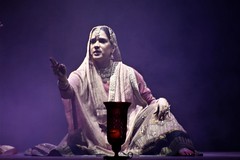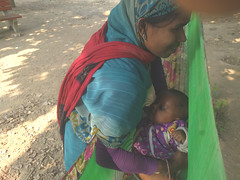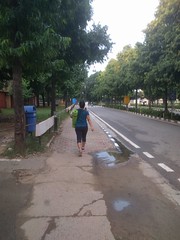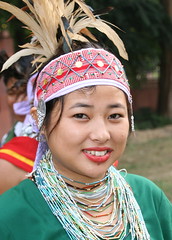Soraya Nulliah: My Art Speaks the Truth to The Violence I Witnessed and Survived
In 2006, Indo-Canadian, feminist artist Soraya Nulliah held a solo exhibition titled ‘SHAKTI’ at the Nina Haggerty Centre in Edmonton, Canada. ‘Shakti’ is a Hindi word that means the feminine embodiment of ‘power.’ Soraya’s intention was to evoke Shakti as she used her art to bring attention to the issues of violence against Indian women. As one review of her exhibition points out: “Under the rich textures and colour, there is a sad theme: the reality of violence against women…” The 50 Million Missing Campaign founder Rita Banerji recently interviewed Soraya Nulliah, and we present their conversations here in this special post. To know more about Soraya, and her art visit her website at www.sorayanulliah.com
Rita: Your family is of Indian origin, but you grew up in South Africa and Canada and now live in the United States. So why did you choose the subject of violence against Indian women as the theme for your paintings and your exhibition?
SORAYA: I am an Indian woman and a survivor of an abusive and violent childhood. So the issue of violence is first of all very personal to me. I know what its’ like to be an abused child, to perpetually live in fear, humiliation and disempowerment. Rita, I remember this clearly even now, so many years later. One day (I was about 17) after my “father” had beaten me up, my “mother” came into my room after and said “Soraya…we have to put up with this…we are Indian women.” And I said to her “you make a choice to put up with it…I don’t“. I spent about 4-5 months at the Youth Emergency Shelter because “home” wasn’t a safe place for me (I was still in high school). Here was my “mother” who was supposed to be my protector, telling me to accept abuse. This pivotal experience changed me because I realized that my silence does not protect me; it weakens me.
While the issue of violence is personal to me, I also know it’s a common experience for so many others, especially women in the Indian community. Every single friend I have in the Indo-Canadian communities either came from an abusive family or was in an abusive marriage, or both.
Everything your campaign against female gendercide in India addresses is happening to Indian women outside of India as well! When I was attending University in Canada, there was an incident near our town of an Indian man who went down to the basement and chopped his wife’s head off while their children were upstairs!!! In the 6 week period that I had my exhibition, there were three Indian women that turned up dead in Vancouver. A story that had me angry and in tears, was about a young pregnant woman who already had a daughter. She was found charred to death and her husband hadn’t even report her missing for weeks. It turned out that she was expecting another daughter!! Violence is an everyday reality for Indian women yet we suffer in silence thinking (hoping?) our silence will save us; it does not.
Rita: What made you different in your response to this violence? After all you grew up in the same community and with cultural diktats that other Indian women in expatriate communities grew up with. If it’s an alternative view and treatment of violence learnt from the larger western society you were living in, then other women of Indian origin are exposed to the same influences, but I’m always surprised how they still end up responding to violence in the same manner that women in India do – which is they learn to tolerate and rationalize it. So what made you different in your response?
SORAYA: It would be very difficult to describe the violence I experiences in my “family” of origin. Not only the physical violence but also the constant assault on my mind, heart and spirit. It left me shattered, broken and carrying the heavy burden of shame that was not mine to carry. I made a solemn vow to mySELF very early on that, once I was able, I would not live my life that way.
My “mother” is a woman with a collapsed psyche…weak and hypocritical. Early on, I made a conscious decision to never be like her. Because I had no mentors or role models in my life, I actively sought them out beyond my family and community. Early on I came across women like Dr. Clarissa Pinkola Estes, Audre Lorde, Alice Walker and Toni Morrison. Their writings showed me a different, braver path and another way to live.
Rita: Your art exhibition initially came up against immense resistance both from the expatriate Indian community and western counterparts. Can you talk a little about that?
SORAYA: The Indian communities reacted to it with complete and utter denial!! I was somewhat prepared for this response but even I was shocked at the depth and breadth of it. Two incidents stand out to me after all this time. A few older Indian women in the “feminist” field in Canada, who while listening, were in abject denial about the whole situation. Some had multiple doctoral degrees in the field of women’s studies. There was this one, very educated lady who headed an Indo-Canadian Women’s association. She became very angry when I asked for her support and said that, while she agreed with me, she would not do so publicly and would not support the message of my art exhibition!!
The second incident regarded a “journalist” for the Wildrose Times of Alberta (an Indo-Canadian newspaper). He interviewed me for over two hours. I spoke about female infanticide, dowry deaths, sati, sex selective abortions etc. I gave him facts and statistics. Yet when the article was published there was absolutely no reference to what I had said!! Instead, he wrote a vacuous article that had little to no grounding in truth.
Rita: I can see why the Indian community would respond this way, but why the resistance in the western response?
SORAYA: Some of the western media, such as the Edmonton Sun newspaper and Shaw T.V., covered my exhibition accurately and spoke passionately about the issues I was addressing. But in regards to the western response in general I think there are a few factors at work.
1. Indians in the west, even the feminists and scholars, don’t speak out about the violence in their families and communities. There is such deep denial. That is why perhaps most people in the west aren’t even aware of it!!
2.I also think that Western feminists don’t really grasp the issue, because the Indian female genocide is subversive, invisible and cloaked in the most insane form of denial. I think it’s almost impossible to grasp the numbers, the inhumanity and the insanity of it all. Those from the west who know of it are perhaps hoping for some magical way to stop this because to accept the reality is too frightening.
3. I think there is also an element of racism and colonialism when it comes to viewing violence against women in other cultures. The western view of the female gendercide in India is that it is a “cultural’ issue and not a human rights one. For some reason we can all agree that Auschwitz and Rwanda are a human rights violation but when genocide is gender base, people seem to think otherwise. This points to the fact that, regardless of what we may say in the west, female lives simply aren’t as valuable as males’. And when those female lives are not white then they are perhaps of even less value – so misogyny gets compounded with racism.
Rita: In some of your paintings the women have their eyes downcast and their heads veiled and bowed. But in others they are looking up, eyes open, heads unveiled. Is there an explanation for this?
SORAYA: The eyes closed and heads bowed refer to how we, in Indian communities worldwide, are in complete and utter denial of the ways we inflict violence on women! The women with eyes bold and open, sometimes angry, express how we have to see the violence, acknowledge it, challenge it and find ways to empower ourSELVES.
Rita: Most of your paintings are of a solo Indian woman. Can you explain why?
SORAYA: There are single women in my paintings because that’s how I see my SELF. I am always standing alone at the edges of cultures and communities; never fitting in completely anywhere.
Rita: Do you feel that female artists and even writers face a certain public resistance to the open expressions of anger against violence on women in their creative works?
SORAYA: Yes I feel that cross culturally, women are generally not supported in expressing their anger. Especially by other women!!
Rita: What was it like growing up in South Africa under an apartheid regime? Were you conscious of what apartheid meant to your life? Did you feel its effect on your life in a certain way – as an Indian girl?
SORAYA: I think I didn’t really understand the impact of apartheid on my life until we immigrated to Canada when I was 12. It was all I had ever known so it seemed “normal” to me. Under apartheid many of the choices we take for granted were not there. We could only live in certain areas and attend specific schools. Non-whites could not vote, hold public office or even travel to certain areas within S. Africa. One of the true evils of apartheid (and there were many) were the walls placed around our minds and hearts; we were told who we could love, marry and be friends with. We did not have free access to knowledge and books. We could not even discuss Nelson Mandela, the ANC or any sort of politics. It wasn’t until the Truth and Reconciliation hearings post-apartheid, when I was in my mid-twenties, that I started to fully grasp the impact of growing up under a Nazi regime.
Rita: How did being a child of the Apartheid regime impact on your vision of race and people?
SORAYA: Under the Apartheid regime your race defined you in every sense of the word. It’s stamped on every legal document and then your life choices are largely determined by it. You don’t even see the person — Just their race. But for me, the one figure that stands out in my childhood was an African lady who was our nanny, who truly loved and nurtured me. I loved her deeply and saw no race or ‘otherness’ in our relationship. She mothered me from the time I was born until we left S. Africa. It was the one true nurturing relationship of my childhood — perhaps even my whole life. Yet, there is blatant racism in Indian communities as well. I am not sure if it stems from the caste system. But there are all these divisions. And skin color is also issue with Indians, who can make the most racist comments about darker skin.
Rita: And how did Apartheid impact on your view of the Indian female gendercide?
SORAYA: Growing up under apartheid instilled in me a strong desire to speak the truth and stand up for what’s right. I don’t take any of my personal freedoms under a democracy for granted. So to speak the truth is not only a right but an obligation. Living under apartheid taught me that the “personal is political’.
Rita: You’ve visited India. What are some of your most memorable experiences? What could you relate to, and what felt totally alien and discomforting?
SORAYA: When I turned 30 I spend 4 months traveling alone through India. It was a turning point for me in so many ways because it led me back to my true SELF. Some of the things I easily related to were customs like eating food with my fingers off a banana leaf, visiting temples and listening to Indian music blaring everywhere. These may seem like superficial things but far from it; they connected me to my earliest childhood memories and to my ancestors.
What I found strange was the lack of women in public spaces. Everywhere I went, women were hidden and not a part of public interactions. Another thing I was horrified at was how some men would come up to me in public and start groping me!!! Even though I was always dressed very conservatively in Indian clothing, because I was alone in public, this seemed to be acceptable behavior.
Rita: How have the different cultures and countries you’ve lived in contributed to the individual that you are?
SORAYA: My identity has myriad influences — Indian, South African and Canadian. They are like threads coming together to form a rich and varied tapestry. I feel equally comfortable sitting barefoot in an ashram as I do marching at a gay rights parade.
But I am also an “outsider” to each of these cultures, not assimilating completely into any of them. While being an “outsider” has been a very painful and isolating experience for me at times, it has also afforded me innumerable gifts. Such as:
- There is no road to follow so I am free to make my own.
- I can be true to mySELF because I am not looking for approval to fit in.
- I am free to take what I want from each tradition and reject what I don’t want. This freedom gives me enormous power to build the model of my own life.
- I can be dangerous! I can speak my mind and tell the truth.
- I can make a unique contribution to the world because I am forced to think outside the box.
Rita: What has it meant for you to be raising your daughter Tara, particularly in context of the other things you talked about in the interview?
SORAYA: The experience of motherhood has been a powerful and deeply transformative one. I tend to be quite concerned because girls are more vulnerable than boys to all sorts of things: child molestations and abductions lowered self esteem, lower grades and interest in math and sciences at a certain age etc. But I also feel having a daughter gives me the opportunity to raise a strong and powerful woman. I know she is going to learn how to be a woman by closely watching and emulating me. This encourages and inspires me to be stronger.
Rita: Do you relive your childhood through her? Does it reflect in how you raise her?
SORAYA: I certainly relive my childhood through her in ways both positive and negative. On the one hand it makes me acutely aware of how abusive and lacking my childhood really was. It opens up layers of memories and abuses that I had locked away in the deepest recesses of mySELF. It also magnifies the lack of nurturing and connection I had to my biological “mother”. On the positive side, because I never got to experience the positive aspects of being a child — I am a true child at heart, and adore creating magical and wondrous worlds with Tara.
Rita: What will you tell her as she grows up? What are some of the things all mothers must tell or do for their daughters?
SORAYA: I will tell Tara the truth about my journey when she is older. My husband Tim and I want to raise Tara to be a strong and independent woman with a strong sense of self, and understanding of her roots in both cultures, Indian and African American. We want her to know that she is loved unconditionally. She will make her own mistakes and, though my inclination is to protect her, I know it is the path to individuation and empowerment.
I think it doesn’t matter what mothers tell their daughters about violence if they tolerate, deny and make excuses for it in their own lives. Children pay closer attention to our actions than they do to our words. Rather than holding up the sanctity of marriage at all costs, our goal should be to create a safe and nurturing environment for ourselves and our children.
I also think it is imperative that women have lives and identities separate from that of mother and wife. I think it’s crucial to building up our self esteem and sense of purpose which will, in turn, carry over to our families in general and daughters specifically. So in fact while I would like to think that being educated would make a difference to how women respond to violence, I don’t think it does. Because I think the real problem stems from being dissociated from the true SELF.
Rita: Your work is very important Soraya. The violence on Indian women, their gendercide, surpasses the violence that any other human group has been subjected to. And you as an artist, a human being and member of this group are a living witness to this violence in your lifetime. Your art is how you bear testimony to it – for now and for generations later. Your anger is an entitlement. If you express it, and it alienates the world, what would you say to the world in response?
SORAYA: If my anger (or pain or empowerment) alienates the world, so be it. The important thing is this: that I am not alienated from mySELF. My art is not about gendercide or about violence against women, but what I hope it bears testimony to is our shared human experience. If my work is to be remembered at all, this is what it is about. Our journeys are all at once deeply personal as well as universal in nature. We all suffer through experiences that leave us broken and vulnerable yet through it all we are resilient and hopeful. There is real beauty in laying claim to our journey.
© The 50 Million Missing Campaign. All Rights Reserved. To cite, please see our copyright guidelines.
Trackbacks
- Soraya Nulliah: The West’s View of India’s Female Gendercide is Sometimes Racist! « GENDER EQUAL: A BLOG ON INDIA'S FEMALE GENDERCIDE
- The #Bollywood Film Heroine Is No #Role #Model for My #Daughter! | THE 50 MILLION MISSING CAMPAIGN BLOG ON INDIA'S FEMALE GENDERCIDE
- Soraya Nulliah: Meine Kunst erzählt die Wahrheit über Gewalt, die ich erfahren und überlebt habe | The 50 Million Missing Campaign: "50 Millionen verschwunden"



























The more Satan has infiltrated a culture, the more that culture will hate females and treat them with violence and cruelty.
We are not sure about Satan, but for sure there is an absence of certain basic human ethics in the culture and the religion that allows for the community’s moral boundaries to permit this. That’s why it is so important that we emphasize the accountability of law, order and human rights which are far more determinate than culture.
In many western families too when there is abuse of children, specially sexual abuse by fathers or the mother’s boyfriend’s, mothers often know and pretend not to. We pretend they are victim’s but they are complicit in the abuse. Mother’s are just as responsible for how they treat daughters (or sons) and what they teach them. Thank you for being so strong and honest.
Domestic violence is so common among Indian families abroad so much so that an Occupational Health Consultant once said to me “Why is that the in-laws and husbands treat the wives poorly in Indian communities? “
From the time memorial the indian psyche has been in denial about women. The two biggest scriptures of India in Ramayana and Maha Bharata are both based on the same subject of exploitation of womanhood. Unfortunately we still live in tribal consciousness in India and suffer from madonna and hoar complex. We either worship the statues of Mother hood or look at ordinary women with no respect. Every day news papers in india are full of girls being gang raped and even the police has this primitive tribal attitude that the women deserve it because they wear seductive clothing etc. We have more spiritual scriptures and temples and gurus in India but the whole country is in the middle of chaos politically and socially. Godblesss